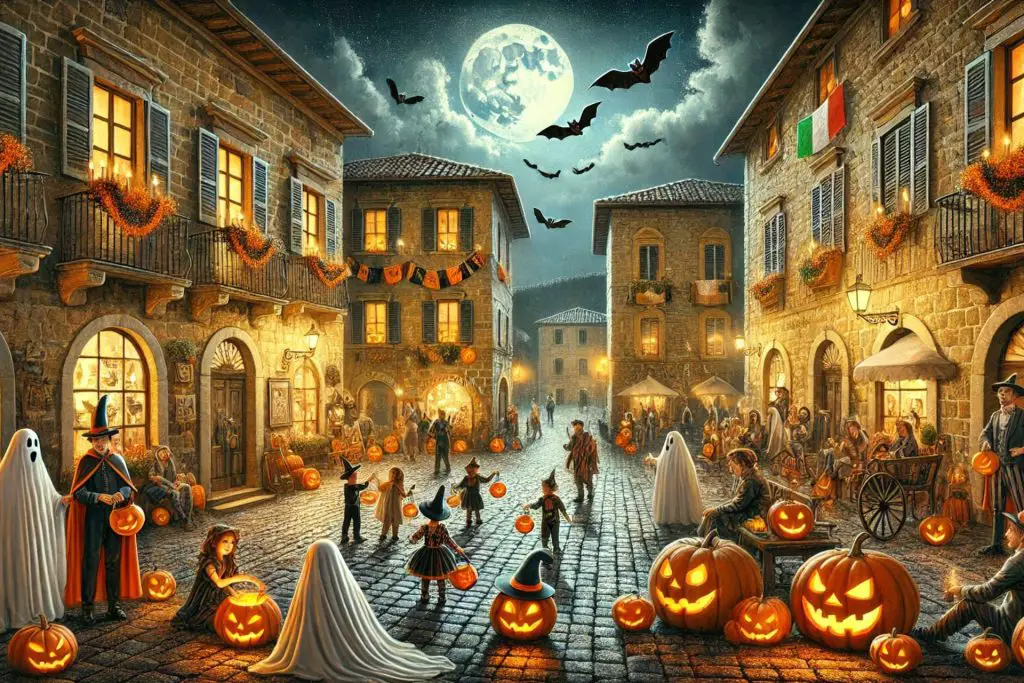Halloween is often seen as a quintessentially American holiday, but in recent years, it has made its way across the Atlantic and taken root in Italy. While the holiday isn’t as deeply embedded in Italian culture as it is in the U.S., its popularity has been growing steadily, especially among younger generations. In Italy, Halloween is celebrated with a unique mix of traditional customs, local interpretations, and a bit of American-style fun. In this article, we will explore how Italians celebrate Halloween, the traditions associated with this period, and the influence of older Italian customs related to the dead and the afterlife.
Halloween comes to Italy: the growing popularity of Halloween in Italy
Halloween wasn’t a holiday widely recognized in Italy until the 1990s, when globalized media and an increasing interest in American culture began to influence Italian society. The holiday’s commercial appeal, combined with the Italian love for costumes and festivities, contributed to its rise in popularity. Today, Halloween parties, costume contests, and themed events can be found in cities and towns across the country. However, Halloween in Italy tends to be less focused on the spooky or macabre aspects. While there are still plenty of witches, ghosts, and skeletons, Italians often put their own twist on costumes, choosing to dress up as pop culture characters, celebrities, or historical figures. Children, in particular, enjoy dressing up and going to parties, although trick-or-treating, known as “Dolcetto o Scherzetto” (treat or trick), is not as widespread as it is in the U.S.
Shopping centers and local businesses often embrace the Halloween spirit, decorating storefronts with pumpkins, fake cobwebs, and eerie displays. Supermarkets stock up on Halloween-themed candies and treats, and restaurants offer special Halloween menus. The holiday has also made its mark in Italy’s amusement parks, which often host special Halloween-themed nights with haunted houses and costumed performers.
Halloween comes to Italy: traditional Italian celebrations of the dead
While Halloween is a relatively new phenomenon in Italy, the country has long had its own traditions related to honoring the dead. Halloween falls just before Ognissanti (All Saints’ Day) on November 1st, and Il Giorno dei Morti (All Souls’ Day) on November 2nd. These days are much more deeply ingrained in Italian culture, especially in regions where Catholic traditions remain strong. Ognissanti is a public holiday in Italy, and it is a day dedicated to celebrating all saints, known and unknown. On this day, Italians attend church services, and many take the opportunity to visit the graves of deceased relatives. Gravesites are meticulously cleaned and adorned with fresh flowers, particularly chrysanthemums, which are the traditional flowers of mourning in Italy. On Il Giorno dei Morti, families gather to remember loved ones who have passed away. In some parts of Italy, particularly in the South, there are ancient customs where it is believed that the spirits of the dead return to visit their living relatives. Families may leave food offerings on tables or windowsills, a tradition that echoes similar practices found in other cultures around the world.
While these traditional observances are solemn and spiritual in nature, they also reflect a deep connection to family and ancestry. In many ways, Italy’s embrace of Halloween is a modern layer added to a much older cultural foundation of honoring the dead.

Halloween comes to Italy: regional Halloween traditions and festivities
As with many things in Italy, the way Halloween is celebrated can vary greatly depending on the region. Each area adds its own flavor to the holiday, often blending Halloween with local customs and festivals that have existed for centuries. In Tuscany, for example, there is the Notte Nera (Black Night), a celebration that takes place in the medieval town of Borgo a Mozzano. On Halloween night, the town transforms into a spooky setting with eerie lighting, theatrical performances, and ghostly processions through the narrow streets. The event culminates in the dramatic reenactment of the “Bridge of the Devil” legend, a local myth that adds to the sinister atmosphere of the night.
In the town of Corinaldo, in the Marche region, Halloween is celebrated with the Festa delle Streghe (Festival of Witches). The town becomes a haven for witches and sorcery enthusiasts, with stalls selling witch-themed products, eerie decorations, and various events dedicated to the supernatural. Corinaldo’s medieval architecture and cobblestone streets provide the perfect backdrop for a Halloween festival that feels steeped in history and mystery. Meanwhile, in large cities like Rome and Milan, Halloween parties are popular in bars, clubs, and cultural centers. These events often cater to both young adults and families, offering a range of activities from children’s games to live DJ performances. The celebrations in urban areas tend to resemble more closely the Halloween traditions of the U.S., complete with costume contests, haunted houses, and pumpkin carving workshops.
Halloween comes to Italy: Halloween treats and specialties in Italy
In Italy, food plays an essential role in every celebration, and Halloween is no exception. Although many American-style Halloween treats like candy corn or pumpkin-flavored snacks are available in some stores, Italy’s culinary traditions during this period remain tied to All Saints’ Day and All Souls’ Day. One of the most common treats associated with this period is Fave dei Morti (Beans of the Dead), a type of almond cookie that is traditionally made to honor the deceased. These small, round cookies come in various flavors depending on the region, but they typically include ingredients like ground almonds, sugar, and sometimes lemon zest or cinnamon. The name “fave” (beans) is symbolic, as fava beans were historically associated with the dead in ancient Roman culture. Another traditional treat is the Ossa di Morto (Bones of the Dead), a crunchy cookie shaped like bones. These cookies are made in different regions of Italy, often flavored with almonds or anise, and are meant to be enjoyed during the period of remembrance for the dead.
In addition to these symbolic foods, Italian bakeries may also create spooky-themed desserts for Halloween, such as chocolate skulls or ghost-shaped pastries. However, the majority of food traditions during this time are rooted in older, more solemn customs associated with the remembrance of loved ones who have passed away.

The future of Halloween in Italy
As Halloween continues to gain popularity in Italy, it is likely that the holiday will evolve, blending more with local customs and traditions. The younger generations, who are more exposed to American pop culture, seem to be driving much of the enthusiasm for Halloween, with costume parties, pumpkin carving, and haunted attractions becoming more common each year. However, Halloween in Italy will likely never completely replace the traditional observances of Ognissanti and Il Giorno dei Morti. These days hold deep religious and cultural significance for many Italians, especially in more rural and traditional regions of the country. Instead, Halloween may continue to grow as a fun and lighthearted complement to the more solemn and reflective rituals of honoring the dead. For travelers visiting Italy during this period, Halloween offers a unique opportunity to experience a blend of both modern and ancient traditions. Whether you find yourself in a lively Halloween party in Rome or participating in the more traditional observances of All Souls’ Day in a small village, you will undoubtedly gain a deeper understanding of how Italians celebrate this fascinating time of year.
While Halloween is relatively new to Italy, it is being embraced with open arms, particularly by the younger generation and in urban areas. At the same time, Italians continue to honor their traditional celebrations of the dead, creating a unique and rich cultural experience during this season.

